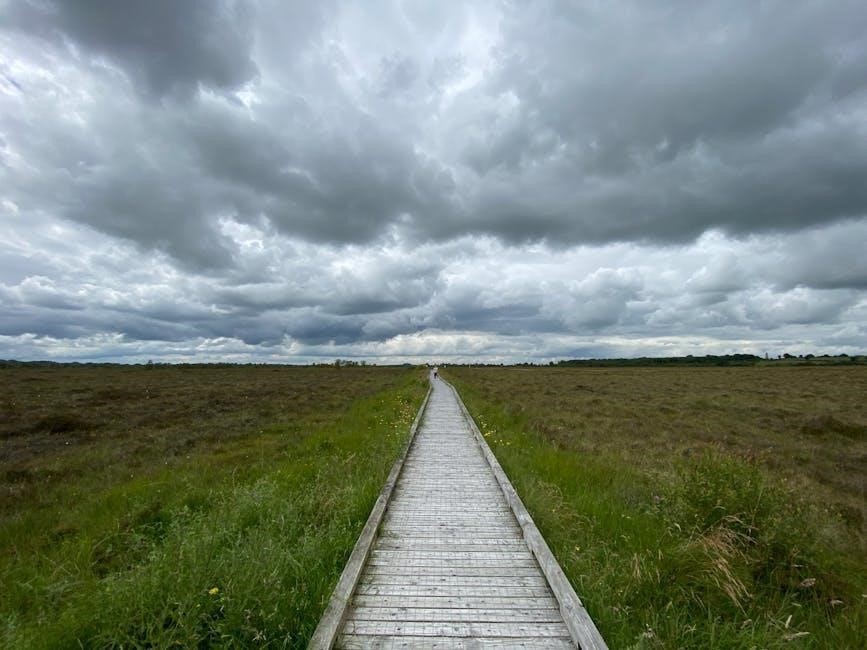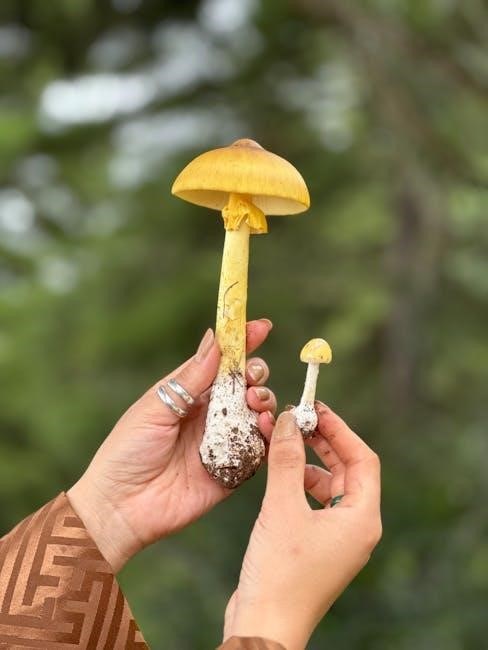The Audubon Field Guide to Mushrooms provides comprehensive information on North American mushrooms with detailed descriptions and photographs‚ making it a valuable resource for enthusiasts and researchers alike naturally.
Overview of the Guide
The Audubon Field Guide to Mushrooms is a comprehensive resource that provides detailed information on North American mushrooms. The guide features a user-friendly format‚ making it easy for enthusiasts and researchers to navigate and find the information they need. With a focus on providing accurate and up-to-date information‚ the guide is an essential tool for anyone interested in learning about mushrooms. The guide’s content is organized in a logical and accessible way‚ allowing readers to quickly find the information they need. The guide’s authors and contributors are experts in the field of mycology‚ ensuring that the information provided is reliable and trustworthy. Overall‚ the Audubon Field Guide to Mushrooms is a valuable resource that is sure to be a useful addition to any mushroom enthusiast’s library or field kit‚ providing a wealth of information on North American mushrooms.
Key Features of the Guide
The Audubon Field Guide to Mushrooms has several key features that make it a valuable resource for mushroom enthusiasts. The guide features a durable vinyl binding‚ making it a great choice for field use. The guide’s full-color photographs are organized visually by color and shape‚ allowing for easy identification of mushrooms. The guide’s detailed physical descriptions and information on edibility‚ season‚ habitat‚ and range make it a comprehensive resource. The guide’s authors have also included information on look-alikes and alternative names‚ helping to ensure accurate identification. With its user-friendly format and wealth of information‚ the Audubon Field Guide to Mushrooms is a must-have for anyone interested in learning about North American mushrooms‚ whether they are a beginner or an experienced enthusiast‚ the guide is a great tool for exploration and discovery of the natural world.

Content and Organization of the Guide
The guide is organized logically with detailed mushroom information and photographs for easy reference always.
Species Information
The Audubon Field Guide to Mushrooms includes detailed species information‚ featuring over 700 mushrooms found in North America‚ with each species accompanied by a physical description‚ information on edibility‚ and habitat details. The guide provides a comprehensive overview of each species‚ including their range‚ season‚ and look-alikes‚ making it an essential resource for mushroom enthusiasts and researchers. The species information is organized in a way that makes it easy to identify and learn about different mushroom species‚ with a focus on providing accurate and up-to-date information. The guide also includes alternative names and facts about edible and poisonous species‚ making it a valuable tool for anyone interested in mycology. With its extensive species information‚ the guide is a must-have for anyone looking to explore the world of mushrooms. The guide’s species information is detailed and informative.
Photographic Identification
The Audubon Field Guide to Mushrooms features over 700 full-color identification photographs‚ showcasing mushrooms in their natural habitats. The photographs are organized visually by color and shape‚ making it simple to identify mushrooms in the field. The guide’s photographic identification system is designed to be user-friendly‚ allowing enthusiasts to quickly and accurately identify different species. The photographs are detailed and of high quality‚ providing a clear view of each mushroom’s characteristics. The visual organization of the photographs makes it easy to compare and contrast different species‚ and the guide’s use of full-color images helps to bring the world of mushrooms to life. The photographic identification system is a key feature of the guide‚ and it has been praised for its accuracy and effectiveness. The guide’s photographs are a valuable resource for mushroom enthusiasts.

History and Development of the Guide
The National Audubon Society developed the guide over forty years with scientific experts and updates reflecting conservation struggles naturally always.
Background of the National Audubon Society
The National Audubon Society has a long history of promoting conservation and education‚ with a focus on birds and other wildlife. The society was founded in 1886 and has since become a leading authority on nature and the environment. With a mission to conserve and restore natural ecosystems‚ the National Audubon Society has been instrumental in protecting habitats and promoting sustainability. The society’s work has had a significant impact on the natural world‚ and its field guides‚ including the Audubon Field Guide to Mushrooms‚ are highly respected resources for nature enthusiasts and researchers. The society’s commitment to education and conservation has made it a trusted and authoritative voice in the world of nature and wildlife. The National Audubon Society continues to be a driving force in promoting environmental awareness and conservation efforts.
Updates and New Releases
The National Audubon Society has released updates to their iconic field guides‚ including the Audubon Field Guide to Mushrooms‚ to reflect the latest scientific research and conservation efforts. These updates are informed by the society’s scientific experts and are designed to provide the most accurate and up-to-date information available. The new releases include revised species accounts‚ new photographs‚ and updated range maps‚ making them essential resources for anyone interested in mushrooms and the natural world. The society’s commitment to staying current with the latest research and conservation efforts ensures that their field guides remain the most trusted and authoritative resources available. The updated guides are published periodically‚ with new editions released as new information becomes available‚ keeping users informed and educated on the latest developments in the field of mycology. The updates are highly anticipated by enthusiasts and researchers alike.

Unique Features of the Guide
The guide features a durable vinyl binding and full-color photographs‚ making it a valuable resource for mushroom enthusiasts and researchers alike every day naturally.
Visual Organization
The Audubon Field Guide to Mushrooms features a unique visual organization system‚ where mushrooms are grouped by color and shape‚ making it easier to identify species in the field. This system allows users to quickly narrow down the possibilities and find the correct identification. The guide’s organization is based on the idea that mushrooms can be identified by their visual characteristics‚ such as cap shape‚ stem color‚ and gill arrangement. By grouping similar-looking mushrooms together‚ the guide provides a logical and intuitive way to identify species. This visual approach makes the guide accessible to users of all levels‚ from beginners to experienced mushroom enthusiasts‚ and provides a valuable tool for anyone interested in learning about North American mushrooms. The visual organization system is a key feature of the guide‚ setting it apart from other field guides.
Full-Color Photographs
The Audubon Field Guide to Mushrooms features over 700 full-color photographs‚ showcasing the diverse range of North American mushrooms. These high-quality images are carefully selected to illustrate the unique characteristics of each species‚ making it easier to identify mushrooms in the field. The photographs are taken in natural habitats‚ providing a realistic representation of the mushrooms as they appear in their environment. The full-color images are a key component of the guide‚ allowing users to visually compare the mushrooms they find with the images in the guide. This visual comparison enables users to accurately identify species‚ even for those with limited experience. The photographs are also useful for documenting and recording mushroom sightings‚ making the guide a valuable resource for mushroom enthusiasts and researchers. The images are a crucial part of the guide’s identification process.

and Recommendations
The guide is highly recommended for mushroom enthusiasts and researchers alike naturally every day.
Importance of the Guide
The Audubon Field Guide to Mushrooms is a crucial resource for anyone interested in mycology‚ providing a comprehensive overview of North American mushrooms.
The guide’s importance lies in its ability to educate and inform readers about the diverse world of mushrooms‚ from edible species to poisonous ones.
With its detailed descriptions and full-color photographs‚ the guide enables readers to accurately identify mushrooms‚ promoting a deeper understanding and appreciation of these fascinating organisms.
The guide’s importance extends beyond the scientific community‚ as it also serves as a valuable tool for outdoor enthusiasts‚ nature lovers‚ and anyone seeking to explore the natural world.
By providing a wealth of information on mushrooms‚ the guide contributes to a greater awareness and appreciation of the natural environment‚ inspiring readers to learn more about the world around them.
Target Audience
The Audubon Field Guide to Mushrooms is designed for a wide range of readers‚ including amateur mycologists‚ outdoor enthusiasts‚ and nature lovers.
The guide is suitable for beginners‚ as it provides clear and concise information on mushroom identification and characteristics.
Experienced mycologists will also find the guide useful‚ as it offers detailed descriptions and photographs of various mushroom species.
The guide’s target audience also includes educators‚ researchers‚ and students‚ who can use the guide as a valuable resource for learning about North American mushrooms.
Additionally‚ the guide is perfect for anyone interested in foraging for wild mushrooms‚ as it provides information on edible species and how to identify them safely.
The guide’s broad appeal makes it an essential resource for anyone interested in mycology and the natural world.